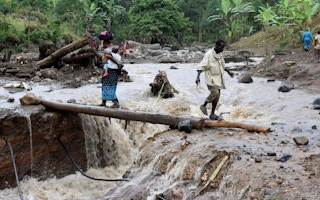Vulnerable countries at the COP26 climate talks urged stronger commitments on finance to help them adapt to climate change impacts and repair the damage they are suffering, in response to an early draft deal for the Glasgow summit released Wednesday.
The two-week annual conference is due to finish on Friday but often runs overtime as countries squabble over wording and hammer out their differences on how to push forward lagging climate action.
Wednesday’s provisional texts urged countries to step up their targets to cut greenhouse gas emissions by the end of 2022, acknowledging that current pledges fall short of what is needed to limit warming to 1.5 degrees Celsius and avert the worst impacts of climate change.
Aubrey Webson, UN ambassador for Antigua and Barbuda and chair of the Alliance of Small Island States, said the deal needed to be strengthened to help the most vulnerable, particularly with finance to adopt clean energy and cope with climate change impacts.
“We won’t get the ambition on emissions (cuts) we need for 1.5°C if we don’t scale up the provision of finance,” he warned in a statement, noting “long overdue” money to deal with growing climate loss and damage was particularly key.
One of the texts noted “regret” that developed countries have yet to meet a promise to channel US$100 billion a year in climate finance to poorer nations starting from 2020 — something they have now promised to do by 2023.
The text urged governments to accelerate efforts to meet the goal sooner.
Abul Kalam Azad, Bangladesh’s special envoy for the Climate Vulnerable Forum (CVF), a club of 55 vulnerable nations in Africa, Asia and Latin America, said there was “no excuse” for meeting the already overdue US$100 billion goal later than 2022.
“Without financial support little can be done to minimise damaging effects for vulnerable communities around the world,” he said.
He noted the CVF wants negotiators at COP26 to mandate that financing options for “loss and damage” — from impacts such as higher seas, and stronger storms, droughts and floods — be studied and then presented at COP27 next year.
That ask has not been included in the decision texts so far.
Vanessa Nakate, a young Ugandan climate activist, also called for a separate fund to help vulnerable countries like hers cope with losses, adding they would experience “suffering, suffering, suffering” if warming tops 2.4°C.
“You cannot adapt to starvation, you cannot adapt to extinction, you cannot adapt to lost cultural heritage and you cannot adapt to lost biodiversity,” she said, calling for loss and damage to be put at the centre of the COP26 negotiations.
‘Challenging’
Mohamed Adow, the director of Power Shift Africa, a Nairobi-based think-tank, said the COP26 decision text was currently “a very lopsided document”.
Its dominant advances include a push to accelerate emissions reductions, and it calls for action to phase out the use of coal and fossil fuel subsidies, the first time such an appeal has appeared in negotiating text at the talks.
“But on the key demands of vulnerable countries there is very little,” he told journalists. “On helping these countries adapt to climate impacts and deal with permanent loss and damage it is very fuzzy and vague.”
A 2022 deadline in the text for all countries to come back with stronger emissions reduction targets was welcomed by many, although some developing nations wanted that targeted mainly at large-emitting nations that have submitted weak national action plans this year.
Some climate campaigners said the text lacked a needed commitment to revise emissions-cutting goals every year, given the urgency of the changes needed.
The conference’s overarching aim is to “keep 1.5 alive” — a reference to the Paris Agreement’s most ambitious goal to pursue efforts to limit average global temperature rise to 1.5°C above preindustrial times.
But a leading tracker for national climate policies this week said the world will hit 2.4°C of warming this century with current plans for 2030 emissions cuts — if they are fulfilled.
“This draft deal is not a plan to solve the climate crisis. It’s an agreement that we’ll all cross our fingers and hope for the best,” said Jennifer Morgan, executive director of Greenpeace International.
“It’s a polite request that countries maybe, possibly, do more next year.”
Alok Sharma, the British official leading the COP26 talks, said the UK government was aiming for a “high ambition” outcome from the summit.
But there was still “a lot” of work to do to achieve a satisfactory outcome on finance in line with the hopes of vulnerable countries, he noted.
He said he hoped new pledges this week would smooth the way.
“We all know what is at risk if we do not reach an ambitious outcome. Climate-vulnerable countries on the frontline of the climate crisis will continue to bear the brunt before it engulfs us all,” he added.
This story was published with permission from Thomson Reuters Foundation, the charitable arm of Thomson Reuters, that covers humanitarian news, climate change, resilience, women’s rights, trafficking and property rights. Visit http://news.trust.org/climate.










